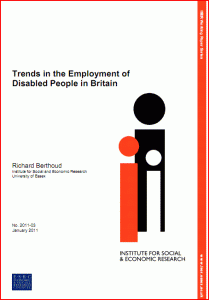The number of disabled men and women claiming out-of-work benefits has been of concern both to policy makers (worried about public expenditure) and to disabled people themselves (worried about poverty). There was a large increase in claims over the 1980s and early 1990s, and the numbers have remained stubbornly high since then, despite efforts by governments of all parties to reduce them.
Benefit statistics tell us very little about the people who do not have jobs, and nothing at all about disabled people who do have jobs. This paper is based on analysis of the series of General Household Surveys between 1974 and 2005. Year on year outcomes for people with limiting long-standing illness (aged 20-59) are compared with those of people with no health problems. This is effectively complemented by more detailed data on health conditions available in some GHS years.
The prevalence of disability (the proportion of working age adults who report a limiting long-standing illness) rose from 14% in 1975 to 18% in 1996, before falling back again to 16% in 2004.
The „disability employment penalty‟ is a measure of the extent to which disabled people are less likely to have a job than otherwise similar non-disabled people. It increased from 17% in 1987 to 28% in 2000 – but has not reduced since then.
These figures refer to all people with limiting health conditions. It is commonly assumed that most of the changes in prevalence and in employment prospects have affected people with relatively minor impairments – but the research shows, on the contrary, that people with severely disadvantaging sets of health conditions have been more, not less, affected by the trends.
Payments of the main social security benefits (Incapacity Benefit and Severe Disability Allowance) lagged behind the number of disadvantaged disabled people in the 1970s and 1980s, especially for women. But they had caught up by 1990.
The detailed analysis made possible by the series of surveys suggests that changes in disabled peoples‟ employment rates or in benefit payments have not coincided.
Disabled people are very sensitive to long-term geographical variations in the health of regional labour markets; while non-disabled people have similar prospects, wherever they live.ii
But disabled people‟s employment is hardly affected by booms or busts in the national economy.
People without educational qualifications are more likely to be disabled, and their employment rates are more affected by disability, than (at the other extreme) people with degrees. Both of these tendencies have increased in intensity over time, so that the current generation of unqualified people has very high rates of disability, and the disabled members of the group have very low rates of employment. But the number of poorly educated people in Britain has been declining over the decades, so very little of the overall growth in the number of disabled people without work can be explained by the skills effect.
The fact that well-educated people are relatively less affected by disability helps to show that it is not disability, on its own, that determines outcomes, but the interaction between disability and opportunities. Disability nevertheless has a substantial effect across the spectrum.
The research helps to counter the idea that some disabled people are unequivocally capable of work, while others are wholly incapable. It supports instead the concept of disadvantage – a sliding scale of employment probabilities affected both by the nature and severity of people‟s impairments, and by the willingness of employers to hire them.
This analysis of the trends over three decades has tended to undermine some of the hypotheses frequently put forward to explain the experience of disabled people.
It is possible that the main shift has been at the boundary point between social convention and labour market activity. The same period witnessed a major positive shift in the economic identity of women with children – mothers have increasingly seen themselves as potential workers. It is possible that an opposite trend is affecting disabled people, who increasingly see themselves, and are seen by others, as permanently unable to work – in spite of the new emphasis on disability rights in public discourse. While employers have become more willing to recruit from the large pool of well-qualified women, they have become less motivated to hire or retain people who combine ill-health with low skill levels.
Download the Full Report as a .PDF by clicking HERE


No responses yet